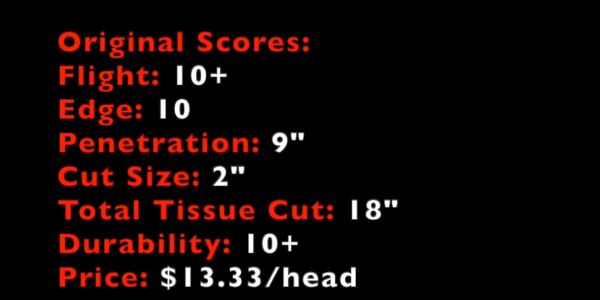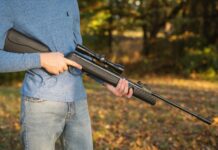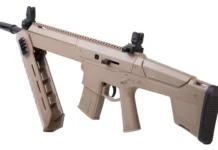Tooth of the Arrow broadheads have been around for while, but I was intrigued and finally got my hands one so I could test it.
Now, Tooth of the Arrow is certainly a cool name for a broadhead, but the company also has a great perk. They are so confident that you’ll like their broadheads, that they advertise that you can get a free sample.
Now that’s guaranteed satisfaction!
You can jump straight to the testing of the Tooth Of The Arrow heads by clicking the links below:
- Tooth Of The Arrow Vented
- Tooth Of The Arrow Solids
Table of Contents
- Tooth Of The Arrow Broadheads | An Overview
- Comparing the Tooth of the Arrow Original to the XL [Broadhead Battle!]
- Final Thoughts On The Tooth Of The Arrow Vented Broadheads
- Tooth Of The Arrow Solid Broadheads Review
- Interesting Ferrule Design On the Solid Version
- Why A Solid?
- Initial Sharpess Test Of The Solid
- Penetration Test 1 Of The Solid:
- Edge Retention Test: (sharpness after Penetration Test 1) Of Solid
- Penetration Test 2 Of Solid: (layered cardboard)
- Durability Test Of Solid: (22 gauge steel plate, max 2 shots)
- Durability Test of Solid: (Concrete Block)
- Final Thoughts On Tooth Of The Arrow Solid Broadhead
Tooth Of The Arrow Broadheads | An Overview
The Tooth of the Arrow broadhead is a 4-blade head that is similar to a Slick Trick head.
Each of the blades are exactly the same cutting diameter, so it’s a true 4-blade head. It’s a little bit bigger than a Slick Trick Magnum. But, rather than being 1 and 1/8-inch cutting diameter like the Slick Trick Magnum, this is 1 and 3/16 cutting diameter. So, it makes a little bit wider hole.
For the testing, I shot 450-grain Bishop mammoth arrows, using my Bowtech SR6 which is a 27 inches and 72 pounds.
What makes this head unique is that this is machined out of a single chunk of high-carbon steel. So, there are no blades to be replaced. It’s just one solid chunk.
So, as a negative, you can’t just replace the blades and put in new sharp ones. As a positive way, it’s a pretty stout, strong design. And, with it being such high-carbon steel, it’s not too difficult to sharpen. So, it’s intriguing to see this.
I’ve spun these heads and they spin very true. They also fly well for me. I’ve not tested them at super long ranges but they do – well, I think through a well-tuned bow, they should fly well at longer ranges.
I’d heard really good things about the smaller, standard head.
But, I’ll start off by testing the XL, which intrigued me the most because I just like to make a big hole if I can! I was excited to see how it performed.
So let’s see how the Tooth of the Arrow XL did. (Further down I’ll do a head-to-head battle between the XL and the original, so check that out as well!
Vented Penetration Testing
I shot it into my broadhead box where I’ve got four layers of MDF and they’re half inch each, and two of those layers have a rubber foam layer in front to simulate hide and a little bit of soft tissue there in the beginning and the end.
Angled Shot Penetration
Next, I shot it at a 1/2-inch MDF board at a 45-degrree angle to see how it would do through that.
Durability Testing
I shot the Tooth Of The Arrow head into a 22-gauge steel plate to see how it would fare.
Cinder Block Test
The cinder block is the final test that I do with the fixed-blade heads.
I don’t do this test or the steel plate test typically with the mechanical heads, but when you’re using a fixed head, you’re typically doing so because you really want to have some structural integrity and blade strength that’s above and beyond what a mechanical can do.
So, I just like to test the limits. Not many heads hold together after hitting the cinder block. A lot of them take chunks out, but then just kind of bend or fall apart. Very few heads hold together. There have only been a few that have made it. Let’s see how the Tooth of the Arrow did.
I would say this head is amongst the top few in terms of structural integrity that I’ve tested. It’s right up there with theQAD Exodus and the Muzzy Trocar and the Trophy Taker A-TAC.
I think the only ones that may have done better are the Bishop Archery and also the Iron Will.
Man, for the price, the Tooth Of The Arrow XL is one impressive head. I have to say, I’m pleasantly surprised. I give it an A+ in all categories.
Comparing the Tooth of the Arrow Original to the XL [Broadhead Battle!]
I wanted to compare the Tooth of the Arrow Original vs the XL version.
Now, I’ve done this in some other instances, like with the Magnus, where I tested the Stinger compared Black Hornet. And in this case, I tested the two models of Tooth of the Arrow broadheads.
#ad
The Tooth of the Arrow broadheads are 100% made in the USA.
I tested these heads for long distance flight (I was able to pop a balloon at 80 yards) and I’m going to test them for edge sharpness and retention, for penetration, and for durability.
Let’s see which one prevails!
These heads have a unique feature about them, in that they keep a lot of the weight within the diameter of the arrow shaft.
Out of the box sharpness comparison
I tested the Tooth of the Arrow broadheads for out-of-the-box sharpness. The purpose is to see if they can still cut paper after a stroke of a carbon arrow shaft. Because both the Original and the XL have the same blades, I only tested one of the heads.
#ad
Penetration comparison
I tested the Tooth of the Arrow Original and the XL for penetration. My medium was ballistic gel that was fronted with a rubber mad and 1/2″ MDF board.
Durability comparison
I shot both heads into a 22-gauge steel plate 5 times to test the durability. Check out the holes these heads made in the steel plate!
The holes themselves are really what sets the Tooth of the Arrow apart. OK. Here you can see the holes from the XL. OK. They are just bit squares. They are not just like four crosses or two crosses, four little slits. They are true squares!
In the steel plate test, there are very heads that are able to punch a chunk out like that. The Exodus does it in a triangular shape. And, as you can see here, the Tooth of the Arrow does it extremely well in a 4-blade shape. So that’s going to be a really difficult hole to close up in an animal.
You can only see on one of the XL blades a little bit of cosmetic marking. I don’t even know if you can pick that up in the picture below. It’s very hard to see.
These heads have extremely impressive durability. Some of the very best that I’ve tested.
Now, I have heard some reports of people shooting them and hitting them into a big heavy bone and one of the blades bending or shearing off. That can happen with any broadhead.
There are all kinds of crazy things that can happen in the field as you hit heavy bone at different angles. But through the steel plate as you can see in the picture below, they faired extremely well.
Cinder Block Test
Let’s look at these heads and see how they did after being shot into the cinder block.
Final Thoughts On The Tooth Of The Arrow Vented Broadheads
So, what do you think of this broadhead battle, the Original versus the XL?
Each of them has their distinct strengths. In terms of overall flight, the Original flies incredibly well. It’s one of the very best flying and forgiving broadheads I’ve ever tested.
In terms of penetration, the Original penetrated much more deeply. But, in terms of hole size, man, the XL really ruled in that department, though both of them really made a nice square hole in the mediums that I shot them through.
And the winner is…
In terms of which one is the winner, really, it’s a toss-up. I have to call it a tie. I hate to do that. But, this really is a draw. It just depends on your personal setup and what you’re hunting.
If you’re going after a really big animal where penetration is the most important thing then man, the Original is the way to go. If you have a lighter setup and you’re concerned about your penetration, then the Original is the way to go.
If you are going after a really long range shot like a pronghorn or something like that that you’re going beyond 60 yards, then the Original is the way to go.
But, if you are going for a shot under 60 yards and you really want to make a nice big hole and you have the kinetic energy to drive it through, (and honestly, it really doesn’t take that much kinetic energy to drive it through), then man, the XL is the way to go. For whitetail and hog shots under 50, 60 yards, I would definitely choose this one.
What I think is the best combination is to have a few of both in your quiver. If a shot is going to be longer, then you pull out the original. If the shot is going to be shorter, use the XL. And that way, you’re ready for any situation, and honestly, any animal as well.
There are several things to consider when choosing a broadhead. These heads have it all. They are fantastic broadheads.
Great job, Tooth of the Arrow!


Tooth Of The Arrow Solid Broadheads Review
Originally, Tooth of the Arrow only made the 100-grain and 125-grain in a vented version.
But they also have a solid, non-vented version in 100-grain and 125-grain.
Interesting Ferrule Design On the Solid Version
So let’s zoom on in here and let’s check out this new Tooth of the Arrows Solids.
What’s interesting in this solid model is that most of the specifications are exactly the same as the vented model.
The overall length is the same, 0.77 inch, making them to my knowledge the shortest single piece for blade steel broadhead that there is, which is just going to aid in flight.
The blades are also the same thickness as the vented model. They are 0.040 inch thick. The blade angle is the same at 45-degree blade angle to maximize the penetration.
And so, the same short profile, the same cut size of 1 inch, and 2 inches of total cut.
#ad
Why A Solid?
So, why come out with a non-vented blade, a solid blade?
Well, many people prefer solid blades over vented blades because they do have some advantages.
One of the advantages is less noise in flight than with vented brodadheads. You have air passing through that hole and it can make whistling or a wheezing sound as it rotates and flies at really high speeds.
So, the solid heads will definitely be quieter.
In addition, a solid can be more durable because there’s not that venting that creates a thin area in the blade that could be more prone to bending or breaking than a solid one. So, that’s the primary reason for doing it.
But, I wondered how it would affect flight and penetration?
In some ways, you might think, “Well, it’s going to fly better, because with these grooves, it’s going to be more aerodynamic in flight.” But, the opposite side of that is, “well, there’s more exposed surface blade than there was in the original, because so much of that blade was covered by the ferrule.”
So, I was curious to see what the flight would be like.
And, same with the penetration. On the one hand, I can say, “well, with this groove, it might penetrate better.”
But, on the other side of that, I go, “well, I’ve noticed that there’s a really thick ferrule. It often opens up a hole for the shaft to just glide through really easily, and those broadheads penetrate more effectively than the ones with a smaller ferrule.”
So, I was really curious to see how all of these things compare.
I tested the 100-grain solid, the 125-grain solid, and for a comparative sake, I compared it to the 125-grain vented.
Initial Sharpess Test Of The Solid
#ad
Penetration Test 1 Of The Solid:
Edge Retention Test: (sharpness after Penetration Test 1) Of Solid
Penetration Test 2 Of Solid: (layered cardboard)
Durability Test Of Solid: (22 gauge steel plate, max 2 shots)
.
Durability Test of Solid: (Concrete Block)
Final Thoughts On Tooth Of The Arrow Solid Broadhead
The solid is going to be a little bit quieter in flight than the vented version and I think the blades are going to be a little bit more durable, because they have that extra support.
However, I think maybe the vented models are going to penetrate just a little bit better and you saw that in the testing. And, I think they might be a little bit more forgiving in really long range flight.
But again, that may be all within the margin of error.
There may not be differences at all in those areas because I think all of them, both the vented, the non-vented are really durable. They fly really well and they penetrate really well.











































